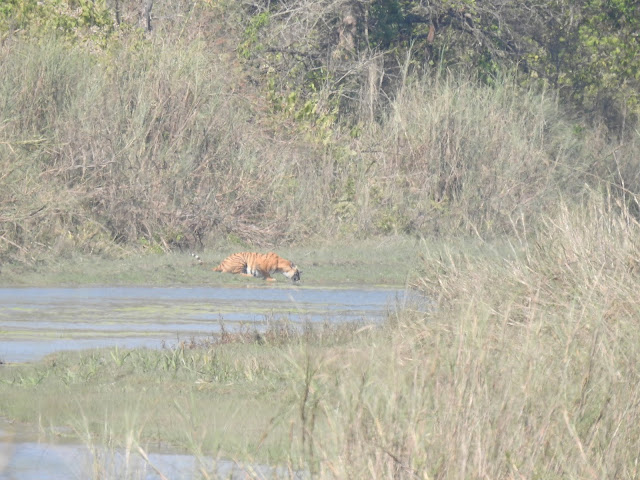What about Bardia National Park?
The largest National Park in lowland Nepal covers an area of 968 sq.km. Situated in Nepal's western Terai, it was established to protect representative ecosystems and conserve Tiger and its prey species. Initially, a small area was gazetted as the "Royal Karnali Wildlife reserve" in 1976.
In 1982, the area was renamed "Bardia Wildlife Reserve" and in 1984, it was extended to its current size and 1500 households of the Babai valley were resettled outside the park, allowing the vegetation and wildlife to flourish. The reserve was given the status of a National Park in 1988.
In 1997, an area of 327 sq.km. of forest and private land surrounding the park, was declared a buffer zone. The National Park and local communities, jointly initiated community development activities and managed natural resources within this zone.
The park extends from the Churia Hills, southward to the gentle slopes of the "Bhabhar". The higher grounds of the Churia have dry, deciduous forest of mostly hardwood sal.
In all, Bardia is home to more than a hundred species of forest trees. The porous slopes of the Bhabhar support large, open grasslands, known locally as "Phantas".
These are some of the last remaining grasslands that once covered much of the Gangetic plain. Many of the larger mammals live in and around the Phantas and so they are the best places to view animals, the most conspicuous of which, is the Spotted Deer.
The western boundary consists of the numerous waterways of the Karnali, which have created many large and small gravel islands. A mosaic of grassland and riverine forest of acacia, sisam and large, buttressed silk cotton trees covers these islands and much of the lower ground area. In spring,the silk cotton blooms and the forest comes alive with scarlet flowers.
The original inhabitants of Bardia were the Tharu people, who possibly migrated from the Thar Desert in Rajasthan, whilst fleeing Muslim persecution, in about the 13th century. They cleared areas of forest in order to plant their crops and supplemented their diet with plentiful game and fish. Much of the Nepalese Terai is still populated by Tharu people.
Bardia is home to 53 species of mammal, 25 species of reptile, over 500 species of bird and 121 species of fish.
Of course, the most famous inhabitants are the majestic, Royal Bengal Tiger and the Greater One-horned Rhinoceros. There are also Leopards and several species of smaller jungle cats, Sloth Bear, Hyena, Wild Dog, Jackal and two species of monkeys: the Langur and the Rhesus Macaque.
It is also famous for its small herds of wild Elephants, which are seen occasionally.
Bardia also boasts small populations of the rare Gharial and Marsh Mugger Crocodiles and the endangered Gangetic Dolphin. The island of the Karnali River harbours the sub-continent's largest antelope species, the Nilgai or Blue Bull.
Both the Karnali and Babai rivers attract a large number of wintering waterfowl, along with resident species such as Herons, Kingfishers and Wallcreepers. Other birds include the endangered Giant Hornbill (Buceros bicornis), Sarus Crane (Grus antigone), Black Stork (Ciconia nigra), Bengal Florican (Eupodtis Bengalensis) and Lesser Florican (Sypheotides indica) - truly a birdwatcher's paradise.
More than 300 butterfly species, over half of Nepal's butterfly populations, may be found in the National Park as well as many snakes and amphibians, including the Indian Rock Python (Phyton Molurus) and King Cobra (Opiophagus hannah) and more than a dozen species of lizards and frogs.
In all, Bardia is home to more than a hundred species of forest trees. The porous slopes of the Bhabhar support large, open grasslands, known locally as "Phantas".
These are some of the last remaining grasslands that once covered much of the Gangetic plain. Many of the larger mammals live in and around the Phantas and so they are the best places to view animals, the most conspicuous of which, is the Spotted Deer.
The western boundary consists of the numerous waterways of the Karnali, which have created many large and small gravel islands. A mosaic of grassland and riverine forest of acacia, sisam and large, buttressed silk cotton trees covers these islands and much of the lower ground area. In spring,the silk cotton blooms and the forest comes alive with scarlet flowers.
The original inhabitants of Bardia were the Tharu people, who possibly migrated from the Thar Desert in Rajasthan, whilst fleeing Muslim persecution, in about the 13th century. They cleared areas of forest in order to plant their crops and supplemented their diet with plentiful game and fish. Much of the Nepalese Terai is still populated by Tharu people.
Bardia is home to 53 species of mammal, 25 species of reptile, over 500 species of bird and 121 species of fish.
Of course, the most famous inhabitants are the majestic, Royal Bengal Tiger and the Greater One-horned Rhinoceros. There are also Leopards and several species of smaller jungle cats, Sloth Bear, Hyena, Wild Dog, Jackal and two species of monkeys: the Langur and the Rhesus Macaque.
It is also famous for its small herds of wild Elephants, which are seen occasionally.
Bardia also boasts small populations of the rare Gharial and Marsh Mugger Crocodiles and the endangered Gangetic Dolphin. The island of the Karnali River harbours the sub-continent's largest antelope species, the Nilgai or Blue Bull.
Both the Karnali and Babai rivers attract a large number of wintering waterfowl, along with resident species such as Herons, Kingfishers and Wallcreepers. Other birds include the endangered Giant Hornbill (Buceros bicornis), Sarus Crane (Grus antigone), Black Stork (Ciconia nigra), Bengal Florican (Eupodtis Bengalensis) and Lesser Florican (Sypheotides indica) - truly a birdwatcher's paradise.
More than 300 butterfly species, over half of Nepal's butterfly populations, may be found in the National Park as well as many snakes and amphibians, including the Indian Rock Python (Phyton Molurus) and King Cobra (Opiophagus hannah) and more than a dozen species of lizards and frogs.


Comments
Post a Comment